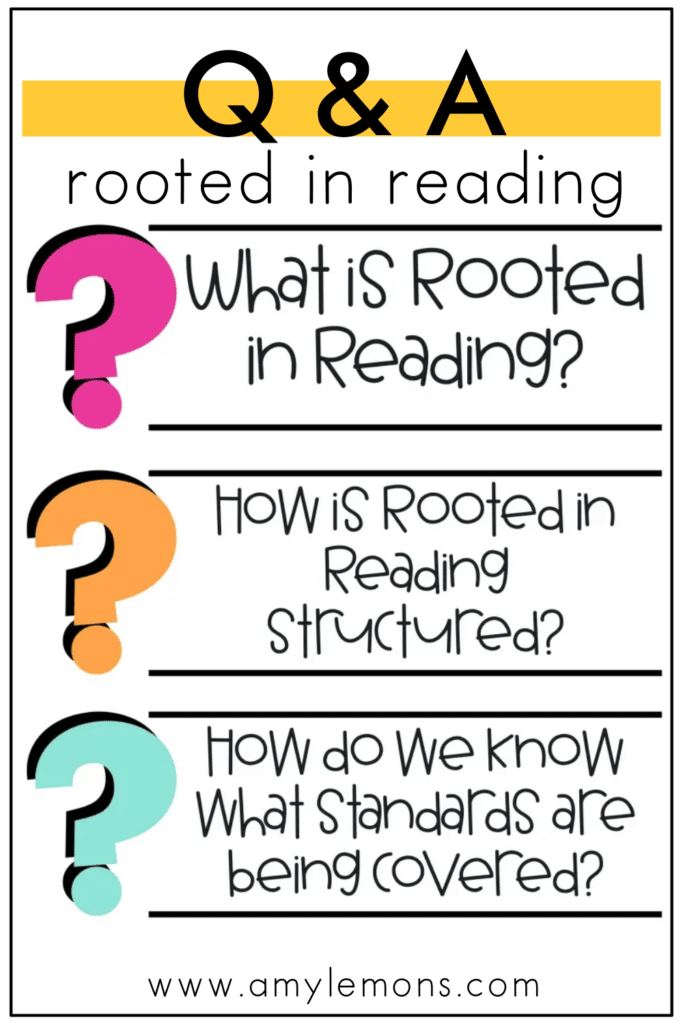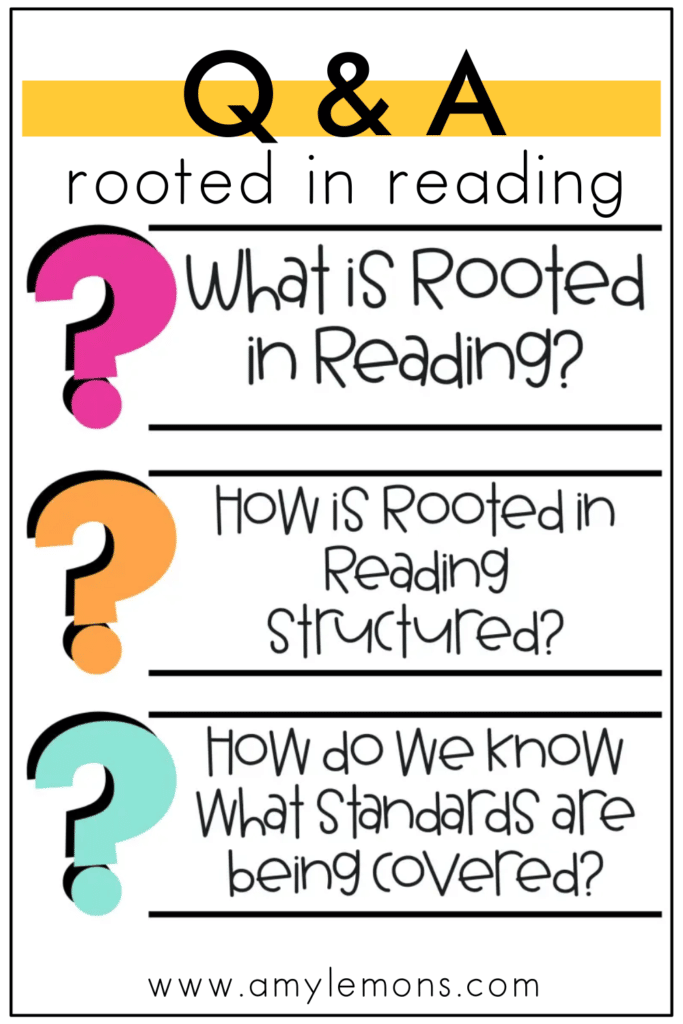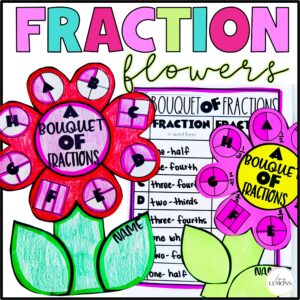

I get so many questions about Rooted in Reading, I’m just going to dive right in and provide all of the answers in one post! I will continue to add questions and answers here as I come across them.


Rooted in Reading is a curriculum created to enhance Language Arts instruction in 1st, 2nd, and 3rd-grade classrooms. Teachers read purposefully-selected picture books to their students each week. Students are actively engaged in listening to and discussing each text throughout the read-aloud. Before, during, and after the read-aloud, teachers guide book conversations through thought-provoking discussion questions. With Rooted in Reading, the learning process continues by targeting specific skills and standards as students interact with this text all week. Activities for each text have been designed to assure students are actively thinking, making connections, and responding to the text in a meaningful way. This curriculum focuses on deepening comprehension, developing and expanding vocabulary, and integrating language skills with the use of a mentor text.

Teachers are provided with lesson plans that include activities and resources for comprehension, vocabulary, and grammar. All of the components are focused around one main read-aloud that is introduced at the beginning of the week, reread throughout the week, and referred to during all of the lessons

Rooted in Reading focuses on one or more comprehension standards each week. We also spiral comprehension skills throughout the year to give students ample exposure and practice. Rooted in Reading does not teach the skills in isolation. The read-aloud serves as a mentor text throughout the week where the students are analyzing the text, making connections, and digging deeper with comprehension by participating in intentional conversations pertaining to the read-aloud.

We have developed an overview for each grade level. It includes the concepts, skills, and standards (Common Core and TEKS) for each book. Click below to find each grade level overview:
Kindergarten Rooted in Reading Overview
1st Grade Rooted in Reading Overview
2nd Grade 1st Edition Rooted in Reading Overview
2nd Grade 2nd Edition Rooted in Reading Overview
3rd Grade Rooted in Reading Overview

We know that many teachers need to show proof to their admin when they are using a curriculum of their choice. We have created a document that houses all of our research, data, quotes from users, etc. You can find that by clicking below:
Rooted in Reading Research Document

They do not! We know so many teachers that move the books around (based on the overview) to fit the scope and sequence of their schools/districts. We suggest aligning it as you see fit. There are some books that you may want to keep in place because they are holiday-specific, but feel free to move the others around!

This question is so hard to answer because every school, teacher, and class is so different. Plus every schedule is so different. The August books and skills are great for the Back to School season, but it truly depends on what you need for your classroom. You may want to choose 2 August books and 2 September books or 1 and 3. I would choose the titles that you like the best and that fit the standards you need to hit. Then save the other books for substitute plans or a time of year when you may need them (For example, some teachers are still teaching in June but we do not have a June unit. You may just need to scoot them around a bit). No matter what, there are 40 books, and unless you go to school for 40 weeks you will have to skip a few!

I finally have an answer to this question!
Click HERE for notebook organization
Click HERE for monthly tub organization
Click HERE for student notebook organization

This will vary based on what you use from the units. Based on the data we collected, most teachers use it for 45-60 minutes. The beginning of the week may take a little longer since you are introducing a book, but as the week goes on the students have more time to respond to the book independently because the mini-lessons are shorter. You can see a post I wrote HERE with how I broke it all down.

You literally cannot fit it all in. We give you so much because we want to make sure you have all that you need. It’s just like any curriculum that you’ve used before… take the bits and pieces that work best for you and your students and focus on those! You may only need 3 days of grammar instead of 5. You may only want 1 writing response and craft instead of 2. And that’s okay! You know what your students need!

Right now we have Rooted in Reading for Kindergarten, 1st, 2nd, and 3rd grades. We get asked a lot about creating units for Kindergarten and 4th grade, but we just aren’t sure yet! We did create a week for 4th grade just to see how it goes. You can find our 4th-grade unit on Being Frank HERE! I promise we will let you know as soon as we begin creating or planning for another grade level.
Kindergarten Rooted in Reading
2nd Grade 1st Edition Rooted in Reading
2nd Grade 2nd Edition Rooted in Reading

We do not necessarily include anything specific for guided reading. Both Katie and I did guided reading separate from Rooted in Reading using leveled readers that our schools provided. However, we know many teachers who use some of the components during their small groups. Many teachers pull things from the nonfiction readers, passages, and vocabulary to use during their guided reading block. Others may take the main comprehension skill and focus on that with leveled readers. I believe you can use certain components, but you also need access to books that are on the different levels of your readers.

Let’s see if I can tackle this question! First of all, Katie always taught with a Reading Workshop model, so it can for sure happen! Let’s look at it like this:
Shared Reading: Read the story to the students and discuss using the book question cards and anchor charts
Listening to Reading: You can find the stories online so that students can listen to the read-aloud again. This might even be where students respond to a vocabulary prompt, interactive notebook activity, or one of your book questions. You can also find books with the same theme, author, etc for students to listen to that pair nicely with your main read-aloud.
Word Work/Vocabulary: During a word workstation or small group students can be working on a vocabulary activity or grammar activity. After you’ve introduced either the words or grammar skills during your minilesson, students can complete the activities independently.
Writing: For a writing station, students can use the directed drawings or writing pages to respond to the text. They can summarize the story, write about the main character, or tie in the comprehension skill for the week.
Those are just a few ideas! It’s all about taking what you already have access to and making it fit into the requirements of your school.


Hey, y’all! My name is Amy Lemons and I am passionate about providing students with both engaging and effective standards-based Math and ELA lessons.

Sample a day of Rooted in Reading with these lesson plans and activities for Reading Comprehension, Vocabulary, and Grammar!



One Response
Hi Amy,
I am super excited to implement RIR in my 2nd grade classroom this year. I have a question about how to share the non fiction readers with my students. We are becoming a 1:1 district this year, so each of my students will have a chrome book. YAY! I was hoping to have them read your non-fiction books during our guided reading time or as the read to self portion of Daily 5. Do you print these books for your kiddos or do you have a good tip to share them with the kids digitally?
Thanks so much!
Dawn